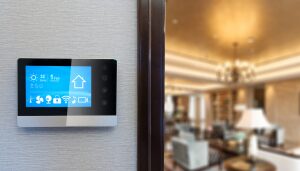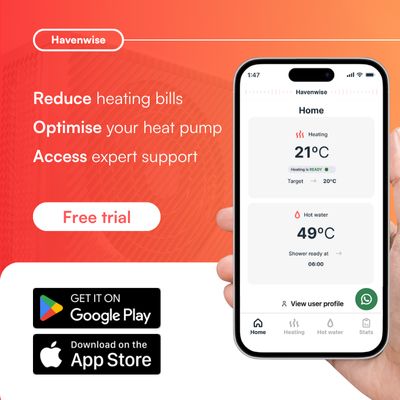Choosing a Home Automation System
In the first article in this series, I explored why you might want to introduce some automation into your home. Now I am going to focus on choosing a foundation on which to build one.
What is home automation?
If you remember, we’ve already seen that if you want your renewable heating technology to work in a truly collaborative way, you will need some system to oversee it all; in current technology buzzwords, this is a “home automation system.” If you do an Internet search for “home automation,” you will get a bewildering array of results because it is actually a very loose term. Assuming you’ve heard the term before, what does it mean to you?
Confusingly, it’s also a very trendy term, trading on people’s predilection for convenience. When did you last see a television for sale without a remote control? Well, now home automation is promising the same kind of functionality to control your home’s lights, doorbell camera, and so forth. That means it’s a very lucrative market that many companies want to be involved with, especially Google, Amazon, and Apple. However, their market dominance means their approach is to create a central bit of kit – a hub – and expect device manufacturers to build to be compatible with their hub; in other words, they want to dominate rather than be flexible. And for small, simple things, that’s exactly what happens. A smart lock isn’t complicated, so most will be made compatible with all the major smart hubs. Ditto smart switches, light bulbs, plugs, and the like. Compatibility with a particular brand of smart hub is a significant part of a customer’s decision to buy one smart device over another.
On the other hand, a heat pump or inverter is a far more complex device, and customers are only really concerned with how well it does its job. Compatibility with a given home automation platform is a side issue at best, and the manufacturers know it. My home is a very small-scale installation in the eyes of my heat pump’s manufacturer – Mitsubishi – and while they certainly provide an addon that would allow the heat pump to be incorporated into a Building Environment Management System (a BEMS) that you might find in a company’s headquarters, they do not invest excess time and money in wide compatibility just on the off chance a domestic home may have Alexa running.
Of course, Google, Amazon, and Apple certainly tout their ability to control your home’s climate, but that’s largely due to a wide range of smart thermostats, all of which have been designed primarily with the expectation they’ll be controlling a boiler, not a heat pump. All this largely rules out most of the home automation solutions you’ve already heard of as the basis for controlling your heat pump, inverter, battery, and so on.
So what should I look for?
What we are after, therefore, is a home automation system that is much more flexible in how it communicates with your kit and is much better designed to deal with more complex pieces of hardware with a wider range of settings to manage. This whittles down the list a lot, and most of the list are not names you would normally come across in the mass media. OpenHAB, SolarAssistant and Home Assistant, to name but three. They are also usually what is called Open Source (developed by communities of developers, and the code that lies in their guts is freely available to see if you’re really so inclined), which is a good thing in some ways and a bit of a hindrance in others. That, however, is a story for another day.
The important thing is that these open-source applications aren’t trying to corner the market, so there is much less territorial fighting. As a result, they are generally written to act a bit like Lego, where if you want to communicate in one way, you install that extra bit. If you want to communicate in a different way with something else, you just install another bit. All very modular and flexible. Naturally, the most flexible of all solutions would be for you to write all the code yourself – and some on the forum have done just that – but that’s more dedication and effort than the average householder is likely prepared to spend.
If we recap for a moment on a point I raised in the first article, we can remind ourselves that our devices are already (probably) communicating with the manufacturer’s own web-based offering. This means there is almost certainly a hidden link called a Web Service (also known as an API) that the device is talking with both for sharing its data and for reading any instructions it needs to follow. That is a very handy tool for home automation developers to exploit since if your device can interact with the web service, so can the home automation hub. As a result, the systems I named earlier are generally able to make themselves compatible with a very wide range of devices without changing the way the devices are installed to work. That makes our integrating job much less disruptive and risky.
In a nutshell?
Of course, there are other ways to talk with our devices, and whether or not we make use of them depends on what we identified earlier as our goals. One key question is whether we want to start cutting out the middle man and start talking directly with our devices, and if that is the case, that adds a bit of complexity to what we need to look for. It is therefore, at this point, worth a bullet point or two to simplify our choices:
- If we’re happy with the way our kit is operating and the decisions it makes, and we’re not that interested in stats beyond what our existing apps tell us, then home automation is simply not necessary.
- If we’re happy to leave the kit as it is but want to really dive into stats, we might want to consider something like Open Energy Monitor ( https://openenergymonitor.org ). This does involve buying some hardware and clipping it onto cables, so it is a bit of a rolling up of sleeves, but it’s non-invasive, so fine for amateurs like me. Knowing what we want to monitor is another question, however.
- If we want to leave the kit largely as it is but centralize the information and also centralize some fairly standard controls, then a pretty vanilla installation of a home automation system is a good option. We’ll just need to pick a system that gives some assurance somewhere that the devices we’ve got will work with it.
- If we want to take a bit more control and start dealing with our devices locally, the details from the previous point apply, but we should also look for a home automation system that supports something called Modbus. It doesn’t mean we’ll necessarily use it, but if it supports Modbus, then that’s a good indicator it’ll also support several other ways of talking locally. For now, let’s just say “Modbus” is a good buzzword to look for in our choice and wait until a later article to see why.
- If we want complete control dealing with our devices locally and want to completely customise the data we retrieve, we always have the option of writing code from scratch. Several forum members have done just that, but since that is a much greater time and effort investment for the average householder in learning how things work, I am not going to make further mention of that approach in these articles. Just know that it’s possible – perhaps even a little easier than you might expect – and is a pathway you can hold in reserve if you ever feel the need.
By way of an example
For myself, I was trying to achieve the following:
- I’d got fed up with my inverter’s web application not working properly, showing the inverter offline, and working in a very confused way. I wanted to take control on my terms.
- I was happy with the way my heat pump was set up, so didn’t see much need to control it as such, but did want to capture stats more easily than via a web app.
- I had moved to the Octopus Agile tariff for import and wanted to be a bit smarter in how and when I used it. As a result, I wanted to link in with Octopus’ systems and start making price-based decisions.
- I wanted to collect information that might give my home automation some context – the weather was a good example.
I ended up settling on Home Assistant largely because it has the widest range of what it calls integrations and gives me the best chance of getting it to talk with pretty much anything I might want to manage. As a result, from here on in I am going to talk in terms of Home Assistant even while acknowledging this particular solution might not be the choice you settle with. It’s an example, not a recommendation.
Now for Home Assistant, there are several choices of how you get started. The cheapest way is also the most techie way in that if you have or can get hold of an old PC of some sort, it is possible to download the Home Assistant software and install it onto that PC entirely free of charge. However, many – possibly even most – people will instead spend around £90 or so and get Home Assistant Green. That is the same software supplied already preinstalled on a small box that just requires putting somewhere and plugging in. It does need a wired network connection, but if you don’t have a network as such at home, then plugging directly into one of the network ports on your internet router is fine. Once that’s done and it’s switched on, then it’s just a matter of using the Home Assistant app on your phone or tablet and doing as it says. Rather than me trying to reinvent the wheel, the “getting started” tutorial is outlined at https://green.home-assistant.io/ .
You can take a look at the Home Assistant demos at https://demo.home-assistant.io/#/lovelace/home to see what it might look like. Alternatively, below are some screenshots of my installation.




If this article feels like a long preamble leading up to advice that is basically “buy a cheap box, plug it in, connect to it with an app, and do what it says,” then that’s a good thing. A lot of work has gone into making the installation process as easy as possible, and if I have helped demystify some of the choices that go into your overall decision, then I’m happy. Your initial install will, of course, present you with much less detail since there are as yet no links with your devices. That is the topic we will be exploring in the next article.
105 m2 bungalow in South East England
Mitsubishi Ecodan 8.5 kW air source heat pump
18 x 360W solar panels
1 x 6 kW GroWatt battery and SPH5000 inverter
1 x Myenergi Zappi
1 x VW ID3
Raised beds for home-grown veg and chickens for eggs
"Semper in excretia; sumus solum profundum variat"
- 26 Forums
- 2,338 Topics
- 52.8 K Posts
- 293 Online
- 5,994 Members
Join Us!
Podcast Picks
Latest Posts
-
RE: What a Bad Heat Pump Installation Looks Like
I agree, except when it is an obvious health and safety...
By Batpred , 7 hours ago
-

RE: Replacing my 18 month old Hitachi Yutaki ASHP
I have been experimenting with different flow temperatu...
By trebor12345 , 8 hours ago
-
RE: Grant Aerona Short Cycling
@damonc I have been playing with this and it is pretty ...
By Grantmethestrength , 10 hours ago
-
RE: Havenwise App Help & Forum Support – Get the Most from Your Heat Pump
@hcas Hello Henri. It is disappointing, but I must pres...
By DavidAlgarve , 13 hours ago
-
RE: Home energy storage & battery register
I have Solax X1-AC with 5.8kWh. Last month we install...
By williamp , 16 hours ago
-
RE: Aira Heat Pump: Stylish Scandinavian Heating
Thanks @gmuzz @mikeh They still mention on the app t...
By ChandyKris , 20 hours ago
-
RE: Experience with Mitsu Par 50/60 Wireless Controller
The 27°C request doesn't boost the weather compensation...
By Sheriff Fatman , 1 day ago
-
RE: Getting the best out of a heat pump - is Homely a possible answer?
Oh and it was installed by Stevie Wonder!
By Grantmethestrength , 2 days ago
-
There seems to be plenty of evidence to support this. ...
By JamesPa , 2 days ago
-
RE: One Year Review: Grant 13kW ASHP - A Catalogue of Errors
@solenoid it sounds like you are making progress. No n...
By JamesPa , 2 days ago
-

RE: LiFePO4 lithium battery fires and explosions
@iaack — thanks, a useful video. They do make it clear...
By cathodeRay , 2 days ago
-
RE: How good is the app support for your heat pump?
I think you are right about the ebus stick. It's cert...
By JamesPa , 2 days ago
-

RE: My DIY Heat Pump installation
@majordennisbloodnok Element-ary my Dear Major.
By Toodles , 3 days ago
-

Welcome to the forums @isaac. What you’re describing is...
By Mars , 3 days ago
-

Win an Eve Smart Home Bundle worth over £350!
Win an Eve Smart Home Bundle worth over £350! ...
By Mars , 3 days ago
-
RE: Is your heat pump insured?
I chose Tesco in the end. Unambiguously cover HP, PV an...
By Davesoa , 3 days ago
-
RE: Help me keep the faith with my air source heat pump installation
@adamk You can get an idea of if your flow and return...
By SimonF , 3 days ago
-
This Solis inverter being rated 8kw and (I expect, as I...
By Batpred , 3 days ago





